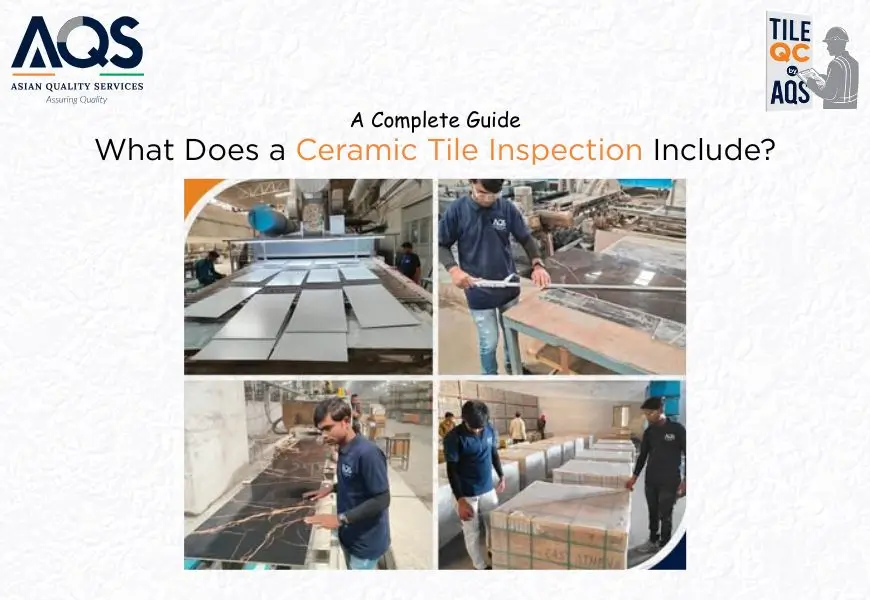
Ceramic tile continues to be one of the most popular materials installed for both flooring and wall coverings throughout the world. Ceramic tile is a durable and incredibly adaptable material that has an infinite variety of colors, patterns, designs, styles, and finishes. When buying tiles, especially in bulk and from a facility in another country (like India), you must check for quality. This is where you come in to do a ceramic inspection!
Going beyond simply identifying visible defects, a ceramic inspection should include technical specifications, measurements, and performance tests. A thorough inspection should ensure that every tile is appropriate to the buyer's needs, as well as comply with the accepted international standards of quality.
In this guide, we will detail what a thorough ceramic tile inspection involves, as well as the importance of doing one.
Why Ceramic Tile Inspection Matters
When tiles arrive at the destination and are not what you were expecting, the repercussions can be expensive, including returns of product, replacement charges, delays, and loss of credibility. An inspection of the ceramic tile can limit those risks by identifying problems before shipment.
Even a reputable factory may have its occasional quality variations due to the sourcing of raw materials, the temperature at which they fire the clay, or the finishing process. Inspections help guard against variations, so you know when the tiles arrive, they will be what you ordered.
1. Visual Inspection for Surface Defects
The inspection process always begins with a visual check. Inspectors will inspect a sample of the batch of tiles for visible defects, such as chips, cracks, scratches, glaze bubbles and pin holes, stains, dirt spots, and glaze defects, and patches of uneven colors or speckling.
These imperfections may appear insignificant in the material at the factory, but the features can be distracting when placed as the finished tile on the premises, particularly in areas of more exposure, such as the family room, kitchen, or commercial area.
2. Dimensional Accuracy
The ceramic tile must fit together perfectly when the installer installs the tile. Size variations will create uneven grout joints, poor tile alignment, and an unprofessional-looking installation.
During a ceramic tile inspection, inspectors measure:
- Length and width
- Thickness
- Squareness of corners
- Straightness of edges
These measurements are compared against the buyer’s specifications and international tolerance standards. Even slight deviations can be unacceptable in high-end projects.
3. Shade and Color Consistency
A shade change is one of the more common quality issues for ceramic tile. While it is typical for some variation to occur because of the firing process, if the tiles in the same batch were radically different from one another, this may hamper the uniformity that buyers expect.
Inspections are done by grouping tiles by shade and then checking them in consistent lighting conditions to make sure they are acceptable in the desired variation. This is an important inspection for large orders, as they may have "run" types mixed in together.
4. Surface Flatness and Warpage
Warped or bowed tiles can cause uneven surfaces and installation difficulties. To prevent this, inspectors check for:
- Edge curvature, bowing along the edges
- Center curvature, bulging, or dipping in the middle
- Twist, unevenness when opposite corners are not aligned
These measurements are taken using precise tools and compared to international standards. Excessive warpage can cause problems not only in aesthetics but also in tile durability over time.
5. Water Absorption Testing
The properties of ceramic tile's porosity directly influence durability, stain resistance, and application in a certain environment. High water absorption of a tile can affect the strength of the tile and can lead to the tile cracking in a freezing environment.
During a ceramic tile inspection, it is common to test samples for their water absorption rates, to find out if they meet the intentions of the install; for example, low absorption ranges for outdoor areas or wet zones and high absorption tolerance for indoor decorative applications.
6. Adhesion and Glaze Quality
Inspectors also check the adhesion between the tile body and glaze layer. Poor adhesion can result in glaze peeling or chipping over time. This is done through visual checks, tapping tests, and sometimes lab-based testing when required.
7. Packaging and Labeling Verification
A quality product can still arrive in poor condition if it’s not packed and labeled correctly. Inspectors verify that:
- Tiles are packed securely to prevent breakage during transit
- Packaging is moisture-resistant
- Labeling includes product name, shade number, batch number, quantity, and other relevant details
Proper packaging also makes it easier for the buyer to track and store the shipment once it arrives.
8. Documentation and Reporting
One of the key benefits of working with a professional inspection agency like Asian Quality Services is the detailed reporting process. A thorough inspection report includes:
- Measurements and test results
- High-resolution photos of the tiles and any defects
- Side-by-side comparisons of actual vs. required specifications
- Clear pass/fail criteria for each parameter
Such reports enable importers to make quick, informed decisions, whether to approve shipment, request corrections, or hold payment until issues are resolved.
Also read: The Hidden Risks of Importing Ceramic Tiles Without a Quality Inspection
How Often Should Inspections Be Done?
Some importers go with final pre-shipment inspections only. But the best practice is to have in-process checks during production. This helps to identify problems early so that the factory has time to correct them before producing the whole batch.
For large or high-value orders, inspections can be scheduled at multiple stages:
- Initial Production Check (IPC) ensures raw materials and early production meet requirements.
- During Production Inspection (DPI), catches issues before production is finished.
- Final Random Inspection (FRI) verifies quality before shipment.
Conclusion
A ceramic tile inspection is not just a ritual; it's an insurance policy against expensive blunders and an essential part of building a trusted supply chain. The inspection does more than surface defects and size accuracy; it covers everything from water absorption, packaging, and shipping containers, so importers know expectations will be met in every shipment.
When working with experienced partners like Asian Quality Services, buyers will have a vetted set of eyes on the factory floor to ensure a real-time quality management program, secure quality, and the ease of business from production through delivery. In today's global, competitive marketplace, this level of quality control isn't a bonus; it's essential.
